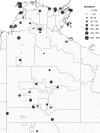Acute post-streptococcal glomerulonephritis in the Northern Territory of Australia: a review of 16 years data and comparison with the literature
- PMID: 21976576
- PMCID: PMC3183781
- DOI: 10.4269/ajtmh.2011.11-0185
Acute post-streptococcal glomerulonephritis in the Northern Territory of Australia: a review of 16 years data and comparison with the literature
Abstract
Data relating to acute post-streptococcal glomerulonephritis (APSGN) from the notifiable diseases surveillance system in the Northern Territory of Australia was extracted and analyzed. Isolates of Streptococcus pyogenes from confirmed cases were emm sequence typed. From 1991 to July 2008, there were 415 confirmed cases and 23 probable cases of APSGN notified. Four hundred fifteen (94.7%) of these were Indigenous Australians and 428 (97.7%) were people living in remote or very remote locations. The median age of cases was 7 years (range 0-54). The incidence of confirmed cases was 12.5/100,000 person-years, with an incidence in Indigenous Australian children younger than 15 years of age of 94.3 cases/100,000 person-years. The overall rate ratio of confirmed cases in Indigenous Australians to non-Indigenous Australians was 53.6 (95% confidence interval 32.6-94.8). Outbreaks of disease across multiple communities occurred in 1995 (N = 68), 2000 (N = 55), and 2005 (N = 87 [confirmed cases]). Various emm types of S. pyogenes were isolated from cases of APSGN including some types not previously recognized to be nephritogenic. The widespread outbreak in 2005 was caused by emm55.0 S. pyogenes. Acute post-streptococcal glomerulonephritis continues to occur in remote Indigenous communities in Australia at rates comparable to or higher than those estimated in developing countries. Improvements in preventative and outbreak control strategies are needed.
Figures




References
-
- Rodriguez-Iturbe B, Musser JM. The current state of poststreptococcal glomerulonephritis. J Am Soc Nephrol. 2008;19:1855–1864. - PubMed
-
- Svartman M, Finklea JF, Earle DP, Potter EV, Poon-King T. Epidemic scabies and acute glomerulonephritis in Trinidad. Lancet. 1972;1:249–251. - PubMed
-
- Berrios X, Lagomarsino E, Solar E, Sandoval G, Guzman B, Riedel I. Post-streptococcal acute glomerulonephritis in Chile–20 years of experience. Pediatr Nephrol. 2004;19:306–312. - PubMed
-
- Yap HK, Chia KS, Murugasu B, Saw AH, Tay JS, Ikshuvanam M, Tan KW, Cheng HK, Tan CL, Lim CH. Acute glomerulonephritis–changing patterns in Singapore children. Pediatr Nephrol. 1990;4:482–484. - PubMed
-
- Zhang Y, Shen Y, Feld LG, Stapleton FB. Changing pattern of glomerular disease at Beijing Children's Hospital. Clin Pediatr (Phila) 1994;33:542–547. - PubMed
Publication types
MeSH terms
LinkOut - more resources
Full Text Sources
Medical

